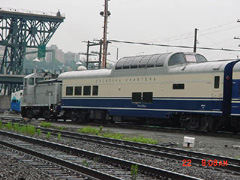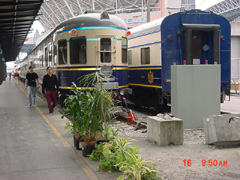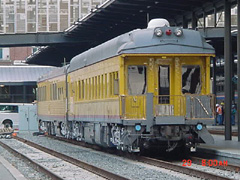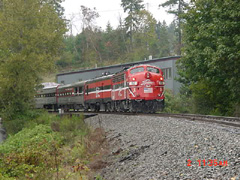|
|

|

|

|

|
|
|
|
|
|
|
|
|
|
|
|
|

|

|
 ROAD-RAILER FREIGHT SERVICES PLANNING GUIDELINES
ROAD-RAILER FREIGHT SERVICES PLANNING GUIDELINES
ATD LINES believes that Road-Railer Freight Services interaction between motor freight and rail continues to be an effective solution to rail line community transportation planning, in which "Road-Railer Freight Services" are reliable, flexible, and efficient contributed to market share for motor trailer to rail freight movements. Congestion in urban rail line community areas and inter city corridors is a growing concern. Truck traffic has become a significant contributor to road congestion and rail line community rail corridors are underutilized. ATD LINES believes underutilization of rail line community corridors increasing the opportunities to move trailer freight by rail, would decrease deterioration of existing highways mobility, while "positively affecting" congestion, safety, pollution and fuel demand issues.OBJECTIVES ATD LINES objective is to develop Roadrailer Freight Services and assess the merits of public investment in "Road-Railer Freight Services" as a viable solutions to relieve roadway congestion and demonstrate how best to incorporate rail line community freight into urban and inter city transportation decision making.ATD LINES Road-Railer Freight Services Project will identify: 1. Rail-freight solutions for current and anticipated capital improvements, 2. Key factors and stakeholders, 3. Obstacles and strategies to overcome. Tasks: To Accomplish Roadrailer Freight Services Project and Objective will require the following tasks.1. Conduct a studies and review all relevant literature, photographic survey's research documents, historical information on rail line community rail freight economics, rail intermodal planning, rail relocation, transportational conflicts, benefit-cost analysis modeling, and public/private partnerships. 2. Identify illustrative examples where rail-freight solutions might apply to relieve present and future roadway congestion problems, as in: a. Congested ports, b. Aging commercial centers, c. Congested interstate corridors, d. Outdated terminal facilities, e. Rapidly growing cities. NOTE 1: Evaluate the potential for rail line community corridor solutions. NOTE 2: Identify key factors that determine whether "Road-Railer Freight Services" or Mini-Intermodal will appropriate or successful alternative. 3. Evaluate impacts of diverting various levels of freight traffic from truck to rail, as in: 4. Identify short-term and long-term trends in rail line community freight movements and land use that affect congestion. Identify the potential "mitigate congestion" or "grade crossing conflicts" through strategies such as: 1. Terminal and track relocation or consolidation, 2. Street closings, 3. Utilization of brownfields and other vacant lands as urban freight centers, 4. Public-sector rolling stock investments, 5. Rail shuttles/mini trains, 6. Improved road access to rail intermodal hub facilities, 7. Inland ports.5. Review existing models, current business practices, and other criteria that should influence decision making on public and private investment Road-Railer Freight Service and other rail transportation. Based on existing resource information and original documented research, outline a preliminary design for a public and private investment decision-making model, including benefit-cost analysis report specific to targeted rail line community. 6. Create an "interim report" to document the results, include a modified work plan to accomplish the remaining tasks, as well as a draft outline of project proposal. 7. Review current policies, practices, and barriers at all levels of government with respect to rail line community passenger and freight,as in: 1. Current levels of investment, 2. Legislative restrictions on funding programs, 3. Time required for project implementation, 4. Environmental permitting requirements. NOTE 1: Summarize "policies and practices facilitate" or inhibit public-sector investment in rail line community transportation. NOTE 2: Recommend how to more effectively include rail passenger and freight in the public and private sector decision-making process at all levels of government. NOTE 3: Assess the feasibility and potential benefits of designating rail line community corridors of national, regional or local significance and propose a framework that would enable major rail passenger and freight policy issues to be addressed, coordinated, and funded on a local basis. NOTE 4: Create framework to address a long-term strategy for coordinated public and private investment in rail line community passenger and freight as a congestion mitigation strategy. Create framework that include consideration of Class 1, short line, local and regional railroads, as well as public and private investment in rail line community infrastructure for transit, commuter,event train, railway business car services and private rail industry and inter city passenger rail services that may result in expanded capacity for rail transportation. 8. Recommend best practices for forming public-public and public-private partnerships for rail line community passenger and freight projects. NOTE 1: Outline and identify how to address the practical, institutional, legislative, and competitive impediments to forming effective partnerships. NOTE 2: Identify the driving factors that will motivate or discourage private or public-sector participation. NOTE 3: Develop guidelines for cost sharing between jurisdictions or between public agencies and private companies. 9. Based on the design developed, deliver a public and private investment decision-making model that including benefit-cost analysis toward specific to rail line communities. 10. Assess the adequacy of the currently available data that was used to conduct the analyses required in Tasks 3 and 4. Suggest methods to improve these data sources in the future. 11. Based on the results of all preceding tasks, develop and deliver a Guidelines and Recommendation Report for assessing the merits of public and private investment in rail transportation solutions to relieve congestion. NOTE 1: Report should include tools for incorporating rail line community trackage into urban and inter city transportation decision-making. 12. Develop an implementation strategy aimed at specific target audiences, as in: 1. Practitioners and decision makers rail line communities and metropolitan areas, 2. Ports facilities, 3. All railroads, 4. State and CommunityDepartment of Transportation, 5. U.S. DOT, 6. Elected officials. 13. Publish final report and executive summary. 
|
![Crossing Gate]](http://www.atdlines.com/motion/train6.gif)
© Copyright 1981-
ATD LINES All Rights Reserved
|